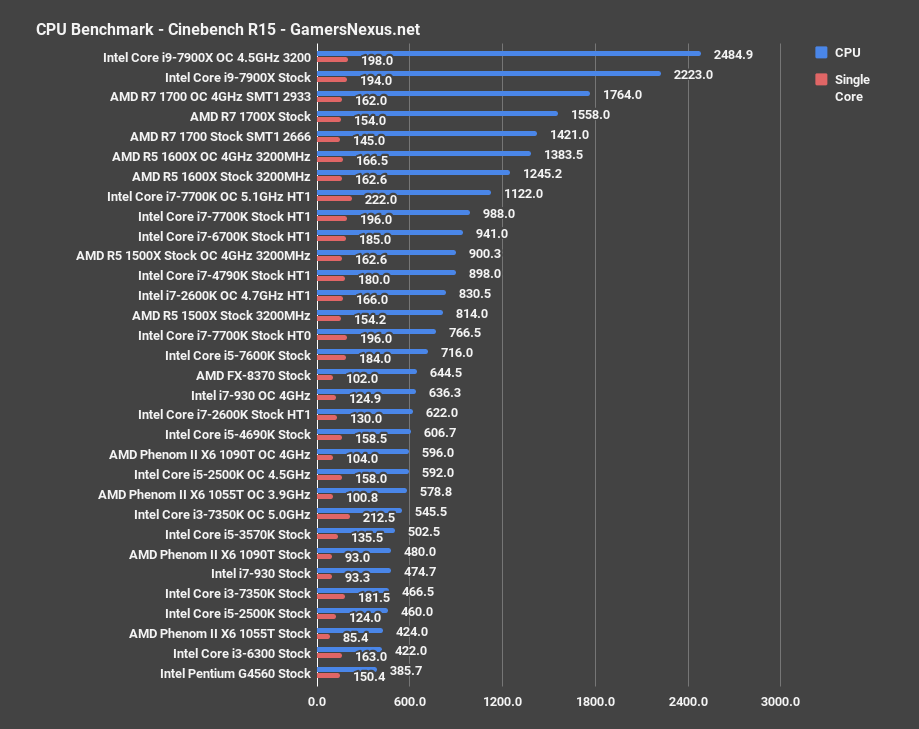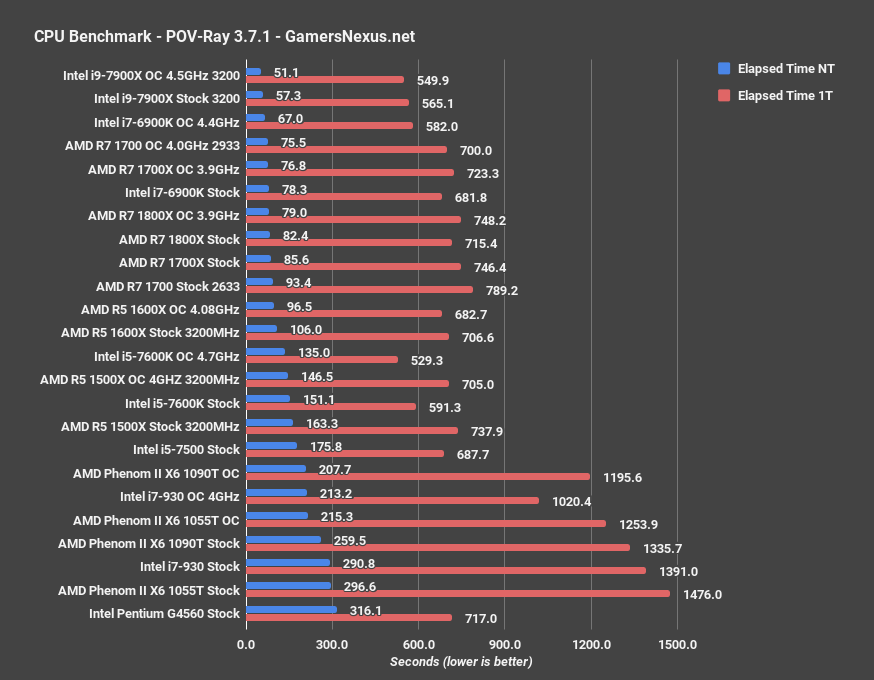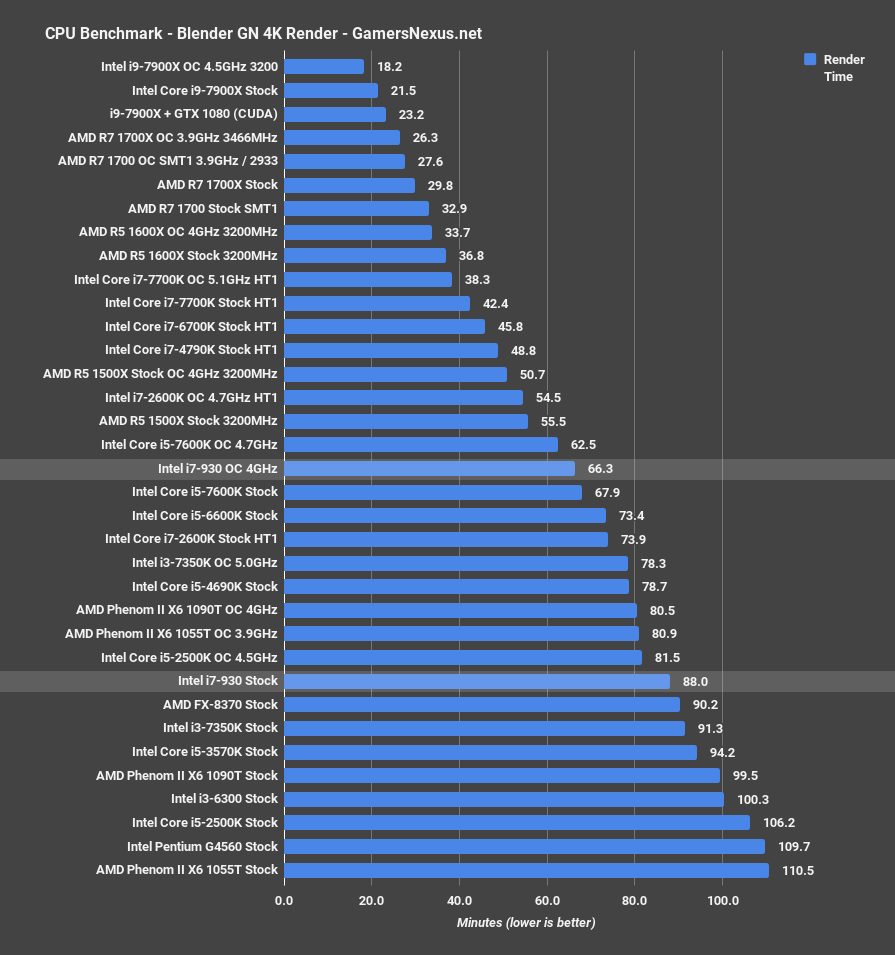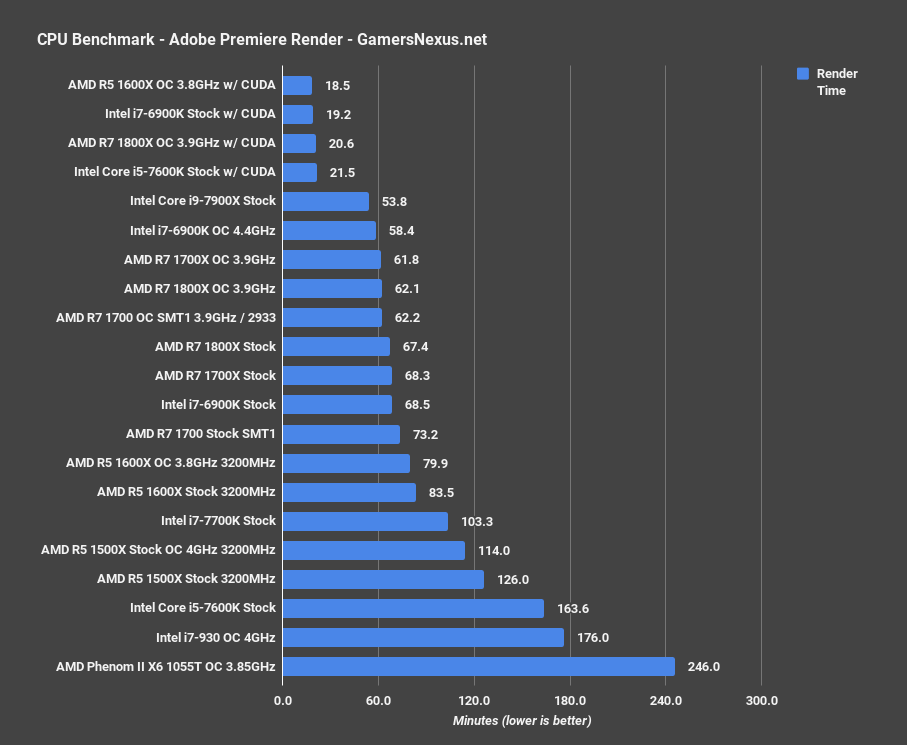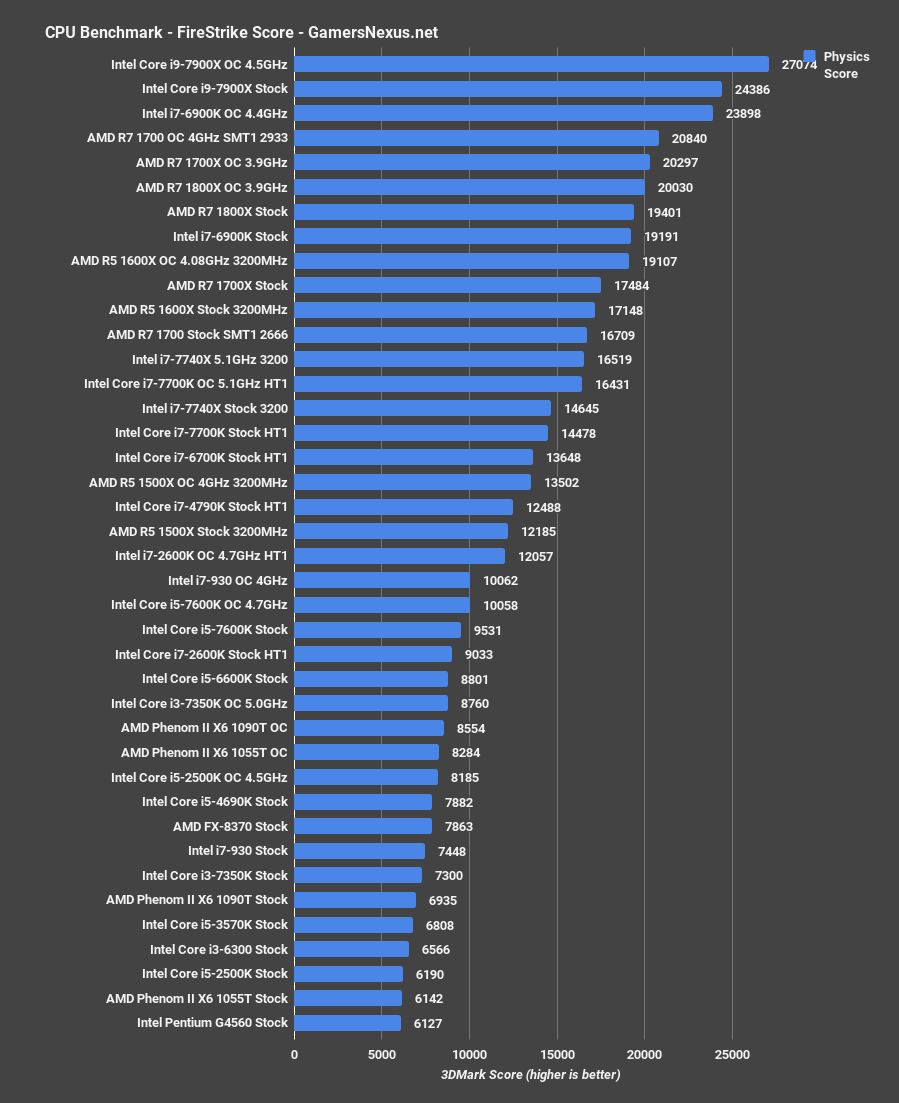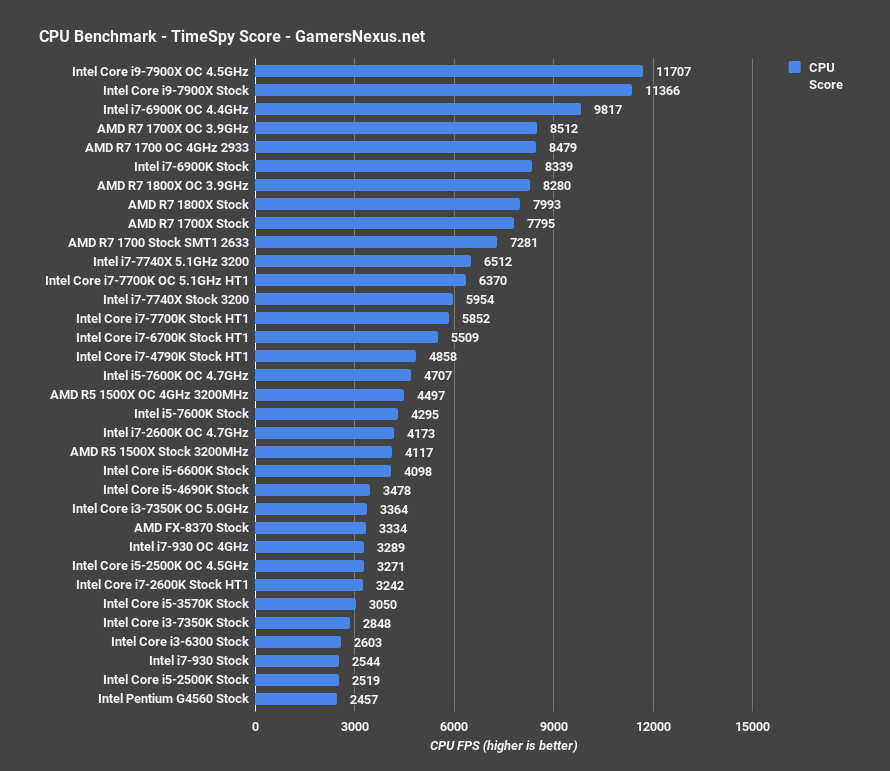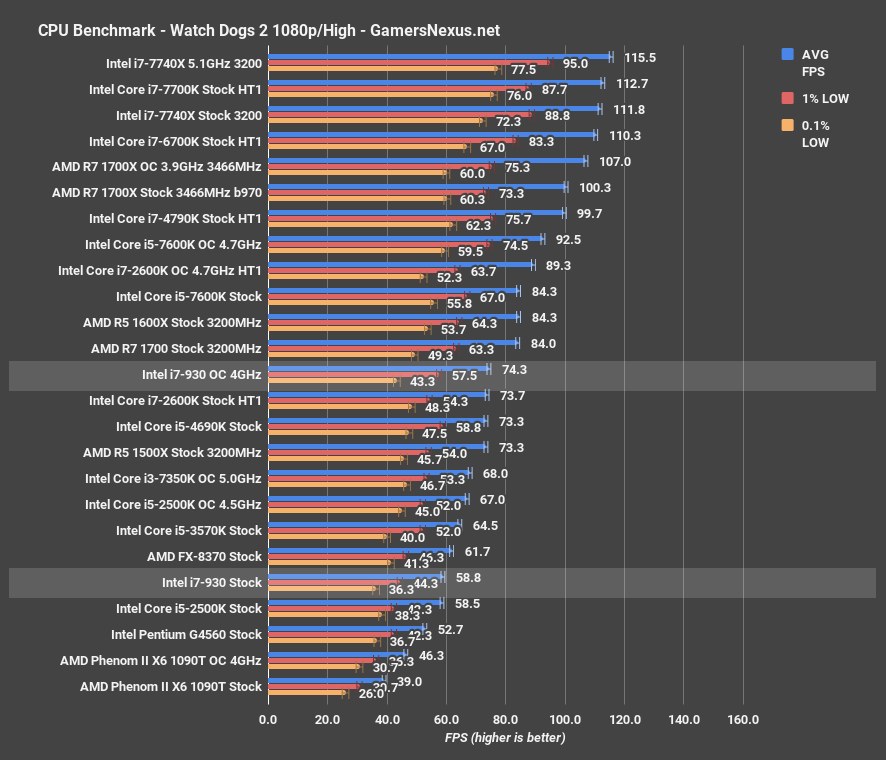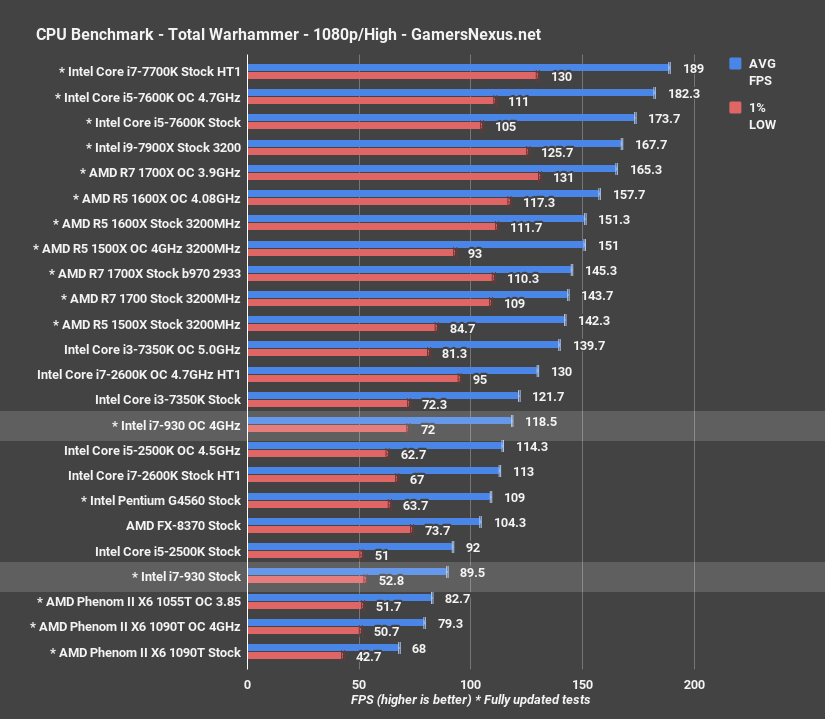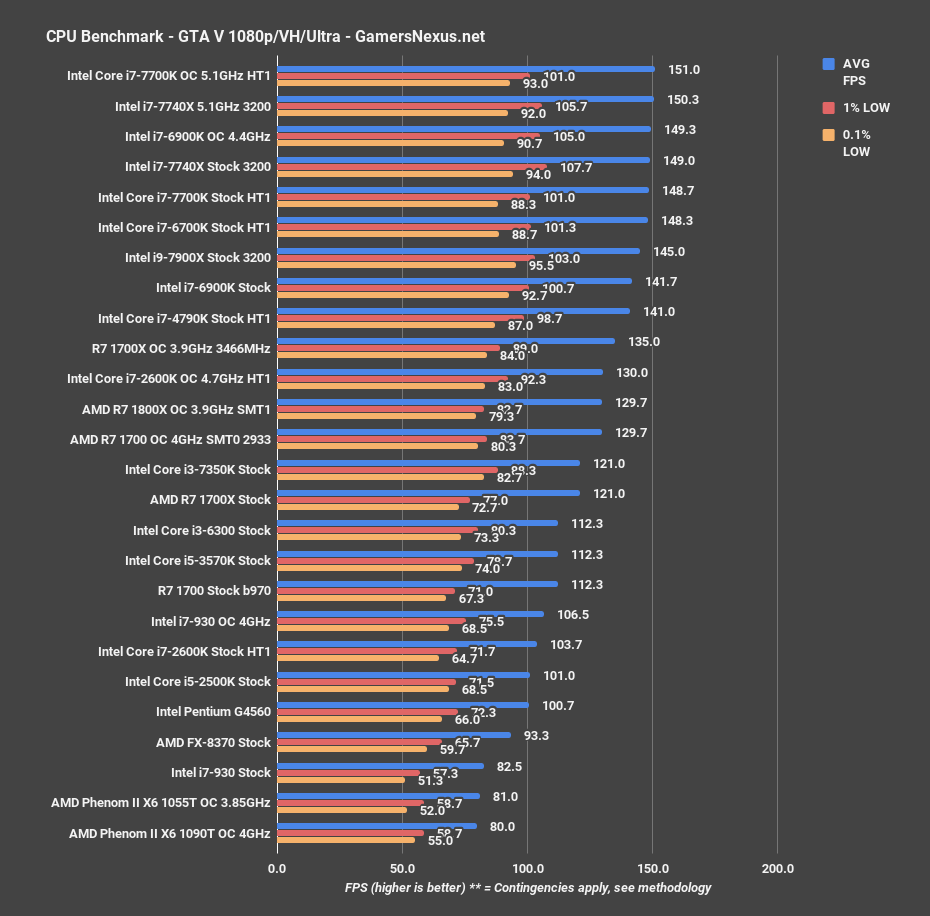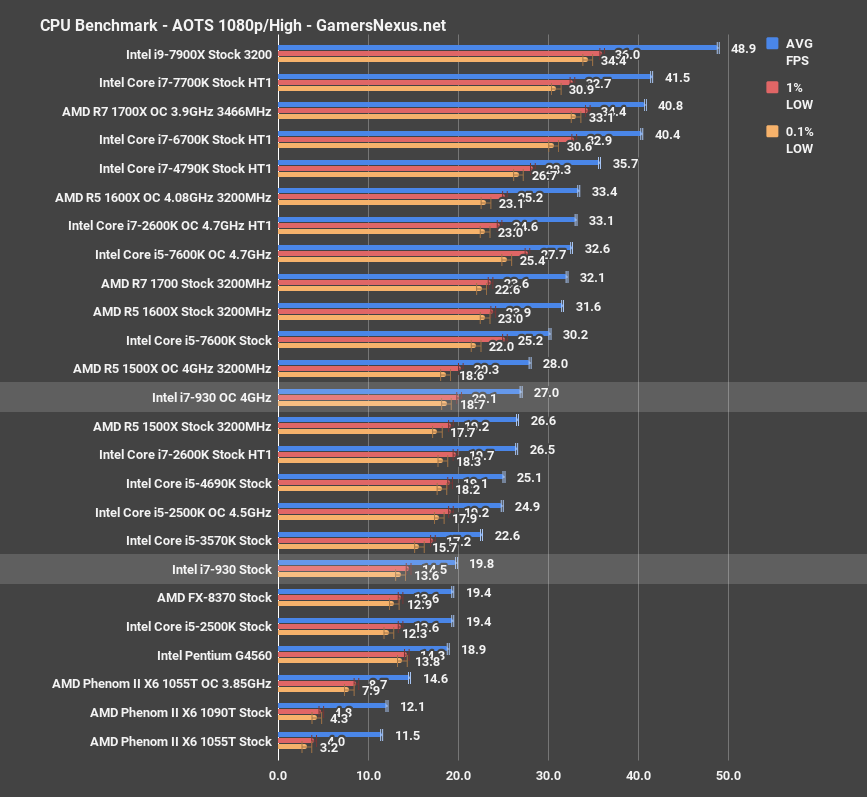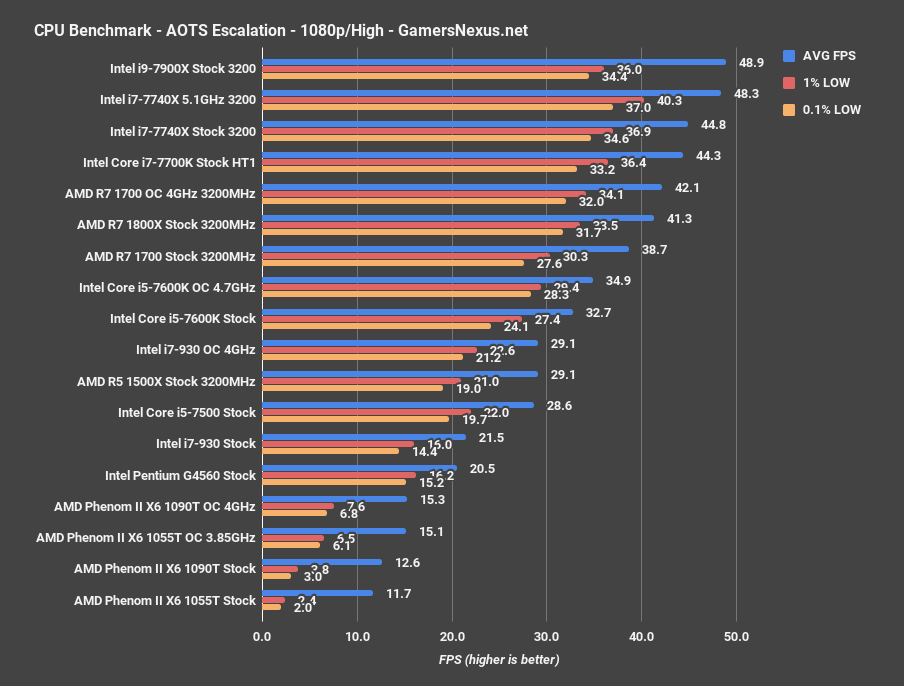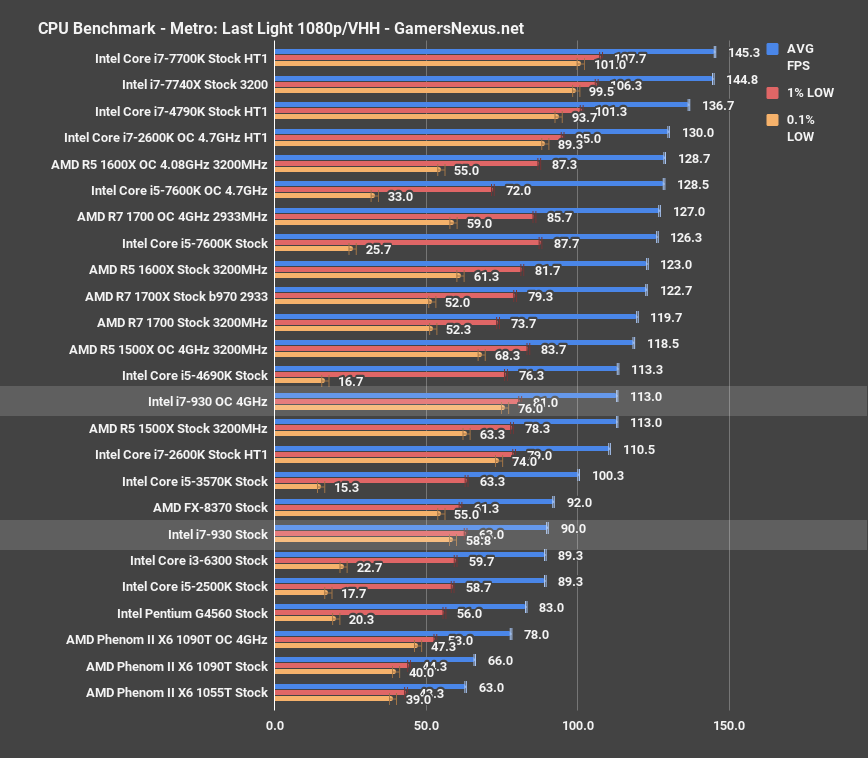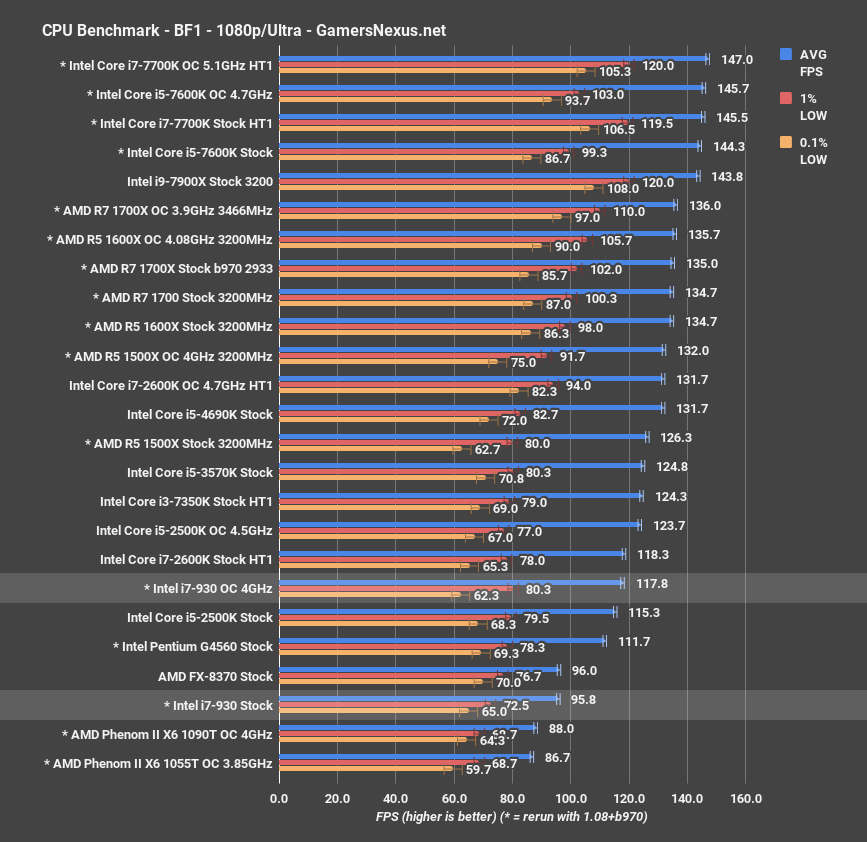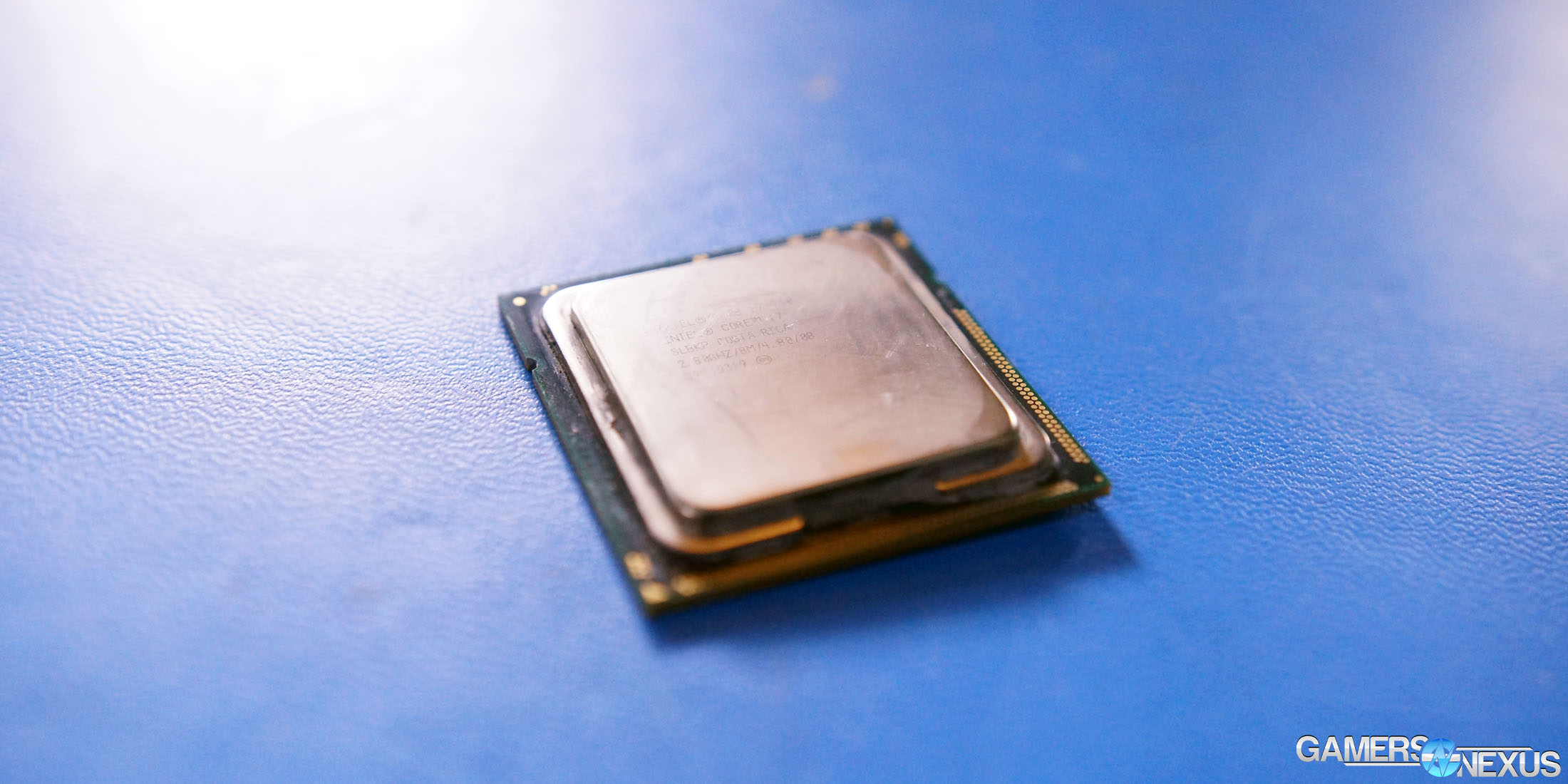Intel i7-930 Revisit - Nehalem Benchmarks in 2017 vs. SB, Phenom, More
Posted on
Our newest revisit could also be considered our oldest: the Nehalem microarchitecture is nearly ten years old now, having launched in November 2008 after an initial showing at Intel’s 2007 Developer Forum, and we’re back to revive our i7-930 in 2017.
The sample chosen for these tests is another from the GN personal stash, a well-traveled i7-930 originally from Steve’s own computer that saw service in some of our very first case reviews, but has been mostly relegated to the shelf o’ chips since 2013. The 930 was one of the later Nehalem CPUs, released in Q1 2010 for $294, exactly one year ahead of the advent of the still-popular Sandy Bridge architecture. That includes the release of the i7-2600K, which we’ve already revisited in detail.
Sandy Bridge was a huge step for Intel, but Nehalem processors were actually the first generation to be branded with the now-familiar i5 and i7 naming convention (no i3s, though). A couple features make these CPUs worth a look today: Hyperthreading was (re)introduced with i7 chips, meaning that even the oldest generation of i7s has 4C/8T, and overclocking could offer huge leaps in performance often limited by heat and safe voltages rather than software stability or artificial caps.
From a historical perspective, the gaming CPUs on our charts that competed with the $294 i7-930 were the $295 Phenom II X6 1090T and $199 1055T (launched later that year), as well as the $216 i5-2500K and the $317 i7-2600K (launched a full year later). That provides some context for how the 930 was holding up in 2010. When comparing these CPUs, it’s important to keep in mind that the Nehalem architecture had already existed for quite some time.
For a modern perspective: from a quick search on ebay, there are multiple listings for i7-930s at or under $40, compared to the overly optimistic $140-ish range that 2600Ks seem to be listed at, or even the $65-ish 1055Ts. Our revisits are typically approached from a “should I keep it” perspective, rather than “should I buy it,” but the i7-930 is selling for even less than G4560s--new or used--putting an interesting spin on these results.
CPU TESTING METHODOLOGY
GAME TEST METHODOLOGY
NVIDIA 376.33 drivers were used for benchmarking. Game settings were manually controlled for the DUT. All games were run at presets defined in their respective charts. All other game settings are defined in respective game benchmarks, which we publish separately from GPU and CPU reviews. Our test courses, in the event manual testing is executed, are also uploaded within that content. This allows others to replicate our results by studying our bench courses.
Windows 10-64 build 14393.1066 was used for testing.
Some benchmarks disable EIST, Turbo, and other features -- please check each section to learn if that is the case. Otherwise, for game benchmarks, assume stock settings (Turbo enabled). We always disable C-states.
Average FPS, 1% low, and 0.1% low times are measured. We do not report maximum or minimum FPS results as we consider these numbers to be pure outliers. Instead, we take an average of the lowest 1% of results (1% low) to show real-world, noticeable dips; we then take an average of the lowest 0.1% of results for severe spikes. GN originally coined the phrases “1% LOWs” and “0.1% LOWs” for these metrics.
EVGA Supernova 750 G2L 80+ Gold
HyperX Savage 32GB 2400MHz (4x8GB)
Corsair Force LE 240GB SSD
Open Air Test Bench
Kraken X62
EVGA GeForce GTX 1080 FTW
Note: fan and pump settings are configured on a per-test basis.
970 (RD9x0) Platform:
-ASUS 970 PRO GAMING/AURA
-Phenom II X6 1055T (125W TDP)
-Phenom II X6 1090T
Core Components (Unchanging)
- NZXT 1200W Hale90v2
- For DDR4 platforms: Corsair Vengeance LPX 32GB 3200MHz
- For DDR3 platforms: HyperX Savage 32GB 2400MHz (note: only 2133MHz was supported on our SNB platform)
- Intel 730 480GB SSD
- Open Air Test Bench
- Cooler #1 (Air): Be Quiet! Dark Rock 3
- Cooler #2 (Cheap liquid): Asetek 570LC w/ Gentle Typhoon fan (this is the one we used for this particular article)
- Cooler #3 (High-end): Kraken X62
- Video Card: EVGA GTX 1080 FTW1
- Note: fan and pump settings are configured on a per-test basis.
Z270 Platforms:
- MSI Gaming Pro Carbon
- i7-7700K (x2) samples from motherboard vendors
- i5-7600K purchased by GN
Z170 Platform:
- MSI Gaming M7
- i7-6700K retail
- i5-6600K
Z97 Platform:
- Gigabyte Z97X G1 WIFI-BK
- i7-4790K
- i5-4690K
Z77 Platform:
- MSI GD65 Z77
- i7-2600K
- i5-2500K
- i5 3570K
AM4 platform:
- ASUS Crosshair VI
Dx12 games are benchmarked using PresentMon onPresent, with further data analysis from GN-made tools.
X58 Platform:
- ASUS Deluxe Pro X58
Some Notes on Memory
Premiere & Blender tests do not exceed 8GB DRAM. Capacity is a non-issue for our testing, so long as it is >16GB. Memory frequency was set to 1866MHz for stock tests and run in triple channel mode (8GB x 3); the same timings etc. were used for OC tests, but with a higher frequency as noted in the next section. Functional memory settings were found by loading an XMP and tuning the frequency from there. To quote AnandTech’s 2008 preview, “Nehalem can get data out of memory quick like bunnies,” but this isn’t something that seriously affects our modern CPU benchmarks.
Overclocking
As usual, we’re taking a fairly casual approach to overclocking: our goal is only to do what a typical user could safely do with an hour or two of experimentation, not to break any records. Not every chip is created equal, and we don’t claim that all 930s will run at 4GHz, nor are we responsible for any damage resulting from overclocking.
We followed this popular guide from 2009, originally written for 920s. Overclocking the 930 was a more difficult process than our other revisits, as we could easily approach potentially dangerous temperatures (with Prime95) and voltages while still maintaining software stability. We made the decision to stop our experimentation at 4GHz, which was the target frequency of the guide linked above and kept temperatures under the rated safe temperature of 67.9C. Yes, we know it could go higher. We mostly used the “quick and dirty method,” although the chip we used was a D0 stepping variant, which potentially can run at lower voltages. Below are some of the settings used for our OC, which unusually didn’t cause any crashes during testing.
BCLK | 191 |
Multiplier | 21 (* 191 = 4.011GHz) |
Memory Multiplier | 10 (* 191 = 1910MHz, actually 1914MHz) |
UCLK | 3829MHz |
QPI Link Data Rate | 6893MT/s |
Continue to the next page for synthetic & render tests.
SYNTHETIC & RENDER TESTS
Cinebench
Our first test was a rough start for the 930. At stock settings, the multithreaded score of 474.7 is below just about everything, including the stock 1090T that it competed with in 2010. It does beat out the stock i3-7350K, but that hardly counts, as the 7350K should always be overclocked and never used for production. The non-overclockable and more expensive G4560 and i3-6300 do lose out, but again, are not designed for rendering.
The 4GHz overclock increased the 930’s score by 34% to 636.3. We’ll include these percentage increases throughout the rest of the review, as one of the most impressive aspects of Intel’s older CPUs is just how much OC headroom there is. That new score isn’t the highest on the chart, but it is higher than its successor, the stock i7-2600K. Single-threaded performance continues to be among the lowest on the chart, despite the increase in frequency, but this matters more in the gaming benchmarks than here.
POV-Ray
POV-Ray’s average render time shrank 26.7% from 290.1 seconds to 213.2 once we overclocked the i7-930. To keep things comparable with Cinebench, that’s a 36.4% increase in pixels rendered per second. Our overclocked 1090T managed to hold its own here, as it completed the render just a couple seconds faster on average. There’s a significant gap between this and the next-fastest CPU, a stock i5-7500--this is one test where the 930 really shows its age.
Blender
Blender’s render time was reduced about the same, 24.7%, putting it right between the i5-7600K’s stock and OC scores. Other i5s, i3s, and the six-core Phenom IIs do worse, as does the stock 2600K, but more modern CPUs with greater than four threads all easily outstrip the aging 930.
Premiere
Overclocked -- as stock would just be unbearably slow -- the i7-930 takes about three hours to complete our Adobe Premiere render. To put this into perspective, the OCed i7-6900K completed in just under an hour, and using CUDA with no overclock at all cut that time by 2/3.
The gist of these tests is that the i7-930 wasn’t a workstation CPU at launch, and it’s even less so now. Still, Blender, POV-Ray, and Premiere all showed about a 25% reduction in render time with a 4.0GHz overclock.
3DMark Firestrike
The i7-930 began to take back some ground with Firestrike. At stock frequency, it again places above the stock i3s, G4560, and stock Phenom IIs, as might be expected. When overclocked, the score shot up by 35.1%, slightly above the overclocked i5-7600K and indeed the rest of the i5s on the chart, where limited threadcount hampers performance.
3DMark Timespy
Timespy is a DirectX 12 benchmark, and it ran flawlessly on the i7-930, unlike the Phenom IIs. As pointed out by readers Nighter3D and PetrolHead, AMD’s pre Bobcat/Bulldozer CPUs lack the SSSE3 instruction set, while Intel created and first introduced it in 2006. Although Timespy ran, it barely outscored the stock i5-2500K. When overclocked, the score increased 29.3%, this time just above the OC 2500K and stock 2600K. That’s still disappointing performance compared to Firestrike, but it gets at least a little credit for even being able to run one of 3DMark’s most modern benchmarks.
Continue to the next page for gaming benchmarks and the conclusion.
GAMING TESTS
Watch_Dogs 2
Watch Dogs 2 is one of the more heavily multithreaded titles, and will provide the next best look at how Intel’s first consumer 8-thread CPU has aged.
The Intel i7-930 Nehalem CPU operates just below 60FPS AVG, with lows at 44 and 36. This places it nearly exactly timed in framerate and frame latency with the i5-2500K, and allows the i7-930 to maintain a lead over the Phenom II X6 1090T 4GHz CPU by 27%. That said, Nehalem looks a bit rough when compared to the 2600K, released just one year later, which operates a 74FPS AVG – 25% faster. Overclocking the i7-930 to 4GHz gets it up to R5 1500X OC levels of performance, both at 4GHz, which isn’t so bad for a CPU made 7 years ago.
For perspective on Intel’s annual scaling: The 7700K operates 92% faster than the stock i7-930, the 6700K operates 88% faster, the 4790K operates 70% faster, and the 2600K operates 25% faster. That’s stock for all those numbers.
Increases in performance via overclocking are slightly less pronounced in non-synthetic benchmarks, but our first game still increased 26.4% in average FPS, well above the 60 FPS mark. 74.25FPS average in Watch_Dogs 2 is not only playable, but higher than many of the other 4- and 6-thread CPUs we’ve tested, which typically don’t perform as well in this test.
Total War: Warhammer
Moving to Total War: Warhammer as a serious CPU stresser, the i7-930 operates a 90FPS AVG with High settings, placing it about 32% ahead of the 1090T stock CPU, with the 2500K roughly tied to the 930. The FX-8370 actually manages to outperform the stock i7-930 in this particular test, operating a 104FPS AVG for a 16.5% lead over the i7-930. The G4560, notably, also manages to outperform the i7-930. Both of these hold a lead because Total War: Warhammer is more clock-dependent than core dependent, as is illustrated by the i7-930 overclocked results – the 930 now runs a 119FPS AVG, permitting it to surpass the 2600K stock CPU.
Just to put these numbers into perspective, the modern i7-7700K holds a 60% lead over the overclocked 930.
GTA V
GTA behaved nicely for once, and even at stock settings, the average FPS was a passable (but relatively low) 82.5 FPS. Overclocked, FPS rose 29.1% to a more competitive 106.5FPS average, with .1% low above 60, and again surpassed the stock 2600K.
AOTS
Ashes of the Singularity is the closest to a synthetic benchmark of the games we test, and the 36.8% average FPS increase from stock to overclocked is more like the increases seen in the synthetic tests than other gaming tests. This the most demanding gaming test we do, and 27FPS average is much more impressive than it sounds.
For the non-Escalation version of the game, the i7-930 stock CPU performs an AVG FPS of 20, with its overclocked variant at 27FPS AVG. This ties the stock i7-930 with the FX-8370, once again, and roughly with the i5-2500K. The i7-2600K stock CPU performs at 26.5FPS AVG, providing it a 34% lead over the i7-930 stock CPU. Overclocking the 2600K gets it to 33FPS AVG, which posts a lessened lead over the overclocked 930 to 23%. The closest Ryzen chip is the R5 1500X, which manages to maintain a 34% lead over the tired i7-930 – though that lead is largely taken away when both are overclocked.
AOTS: Escalation
Escalation is basically the same test as vanilla Ashes of the Singularity, but it is a newer version of the game. Due to some differences in the “high” preset between versions, absolute scores are spaced, but the difference between stock and OC is nearly identical: a 35.4% increase.
MLL
Metro: Last Light at 1080p posts the Intel i7-930 stock CPU at 90FPS AVG, with lows at 63 1% and 59 0.1% -- sustained reasonably well thanks to the eight threads on the CPU. The 2010 i7-930 stock CPU is positioned just behind the 2014 FX-8370 stock CPU. For a comparison that everyone can relate to, the i7-2600K stock CPU operated an average of 111FPS, posting a 22% lead over the 930. The 4.7GHz overclocked 2600K counterpart places at 130FPS AVG – or adjacent to an i7-4790K and R7 1700 OC. Overclocking the i7-930 Nehalem CPU to 4GHz gets it up to 113FPS AVG, with high frametime consistency in the lows. Thanks to the OC, we’re now outperforming the i7-2600K and R5 1500X stock CPUs.
The oldest game in our tests gives the best picture of how the i7-930 performed within its expected lifespan.
BF1
For Battlefield 1, the i7-930 runs an AVG FPS of 96, placing it just ahead of the X6 1090T 4GHz OC and just behind the FX-8370 stock CPU. The closest Ryzen CPU is the R5 1500X at 126FPS, for a 32% lead over the stock 930. The 2600K, for reference, is about tied with the overclocked 930 and about 23% ahead of the stock 930 – this seems fairly consistent with other tests, where the 2600K generally maintained a lead of at least 20% stock-to-stock testing.
Conclusion
The difference between Intel’s CPU generations were huge leaps around 2010. Overclocking the i7-930 was mostly painless, and we saw 35-ish percent performance increases in synthetic benchmarks, and 25% or greater in games by going from 2.8 to 4GHz. Despite this, our 4GHz i7-930 was equivalent in most benchmarks to a stock i7-2600K, a CPU released only a year later for a moderately higher price.
As we recommended with the 2600K (or any CPU), current owners of the i7-930 that are considering an upgrade should first ask themselves if they’re unhappy with performance. There are massively more powerful CPUs on the market now, but it’s possible to play modern games at medium/high settings on a 930. GPU-bound games like Overwatch will be minimally affected. The biggest problem with using old CPUs, as we’ve mentioned in past revisits, is the lack of compatibility with modern features. We don’t experience these issues much as a daily user might, since we just need the system to boot up and run some tests, but we’ve had problems with memory frequency, DirectX 12, and overclocking stability, to name a few. With the i7-930, though, not a single crash or problem occurred (other than the ones we caused directly) throughout testing.
The i7-930’s apparent cheapness on the used market might tempt a few readers into making an ultra-budget system, but there are a few factors to consider first. Finding a working X58 motherboard for a similarly discounted price is much more difficult. Additionally, used 930s and X58 boards being sold in 2017 have probably been used for overclocking at some point, making them a risky purchase. The i7-930 must be overclocked to be worth buying now, but it’s impossible to tell how high a chip will go without testing it. 930s obviously don’t have IGPs, so a discrete GPU is necessary. The “upgrade it later” argument doesn’t work at all, either--the DDR3 memory and X58 board would need to be replaced at the same time. Of the CPUs we’ve tested lately, the G4560 is the best candidate for ultra-budget builds or as a placeholder for a more expensive chip. We wouldn’t recommend buying any CPU this old for regular use, although it could be an interesting experiment for some.
Editorial, Testing: Patrick Lathan
Test Lead, Host: Steve Burke
Video Production: Andrew Coleman
